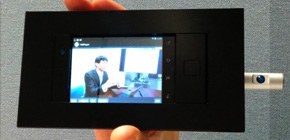
Interruption-free video delivery system for mobile terminal devices developed!
Next-generation video-on-demand service for mobile phones merely a matter of time.
YOSHIHISA Tomoki (Associate Professor, Cybermedia Center, Osaka University) has developed a video delivery system for mobile terminal devices (such as smartphones) that encounters few interruptions compared to current delivery systems. Conventional communication systems for mobile terminals often break the flow of the video due to changes in the reception of the electromagnetic signal. This newly developed communication system makes it possible to view videos with few or no interruptions. This technology will lead to the development of next-generation video-on-demand services for mobile phones.

Conventional video delivery systems for computers were intended for desktop computers, not for mobile terminal devices. In the case of mobile terminal devices, variations in the strength of the electromagnetic signal changes as the location of the receiving device changes or the number of clients increases. Naturally, there is a capacity limit for the signal that can be broadcast. Consequently, interruptions are not unusual during video reproduction on a smartphone, tablet computer, or other such device using a conventional video delivery systems.
Naturally, such interruptions interfere with the viewer's enjoyment of the video. Thus, video delivery services capable of delivering a product without interruptions have been a target of research.
In order to achieve next-generation video-on-demand regardless of the environment, Prof. Yoshihisa succeeded in developing a delivery system using technologies such as stream-merging technology, preliminary data delivery, and a data rate used in relation to the residual level of the battery in Hybrid Broadcasting Environments.
" A Mobile Video-on-Demand System for Hybrid Broadcasting Environments ," Proceedings of the International Conference on Advanced IT, Engineering and Management (AIM-14), pp. 50-51, Feb. 2014.
Related link :

